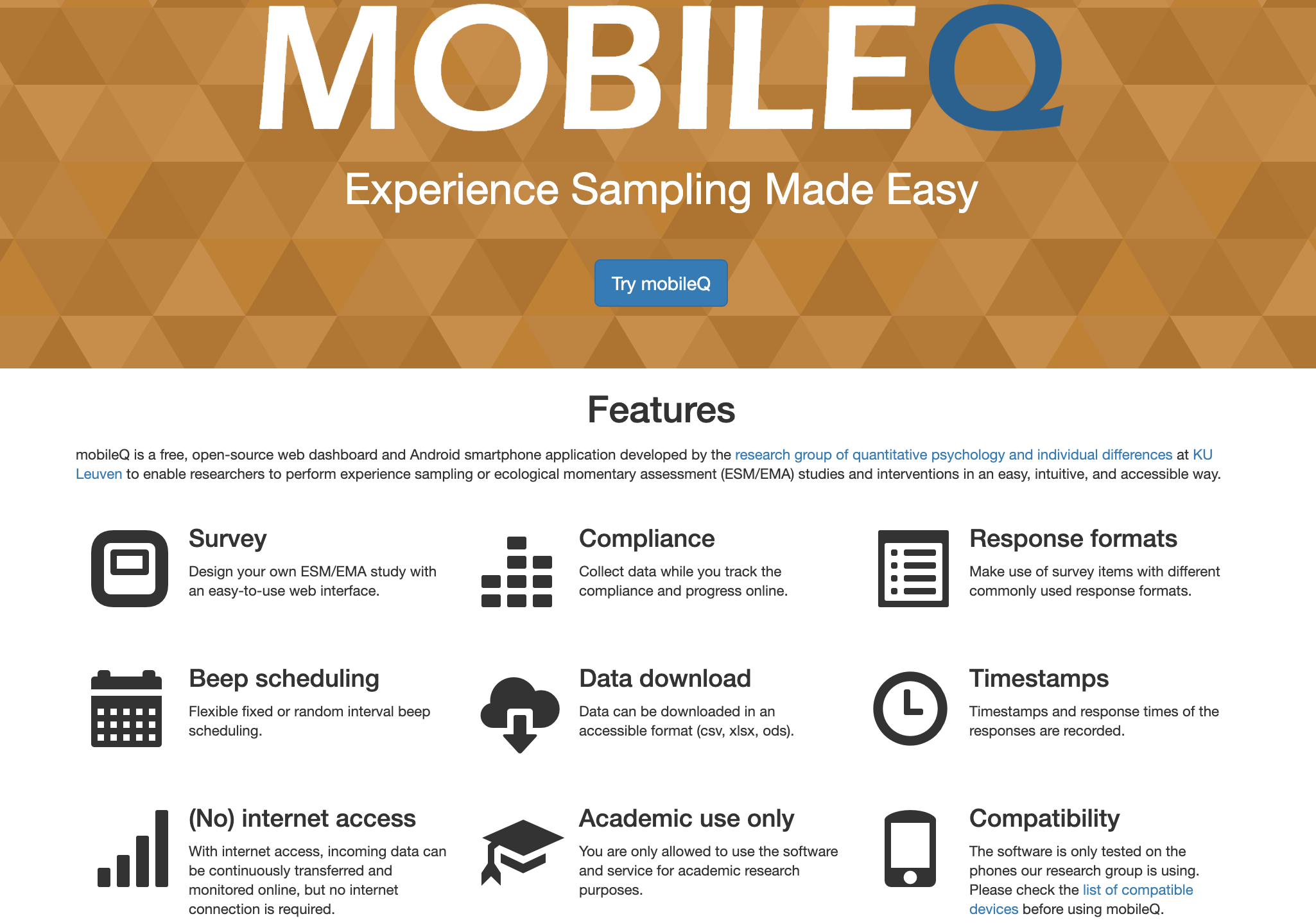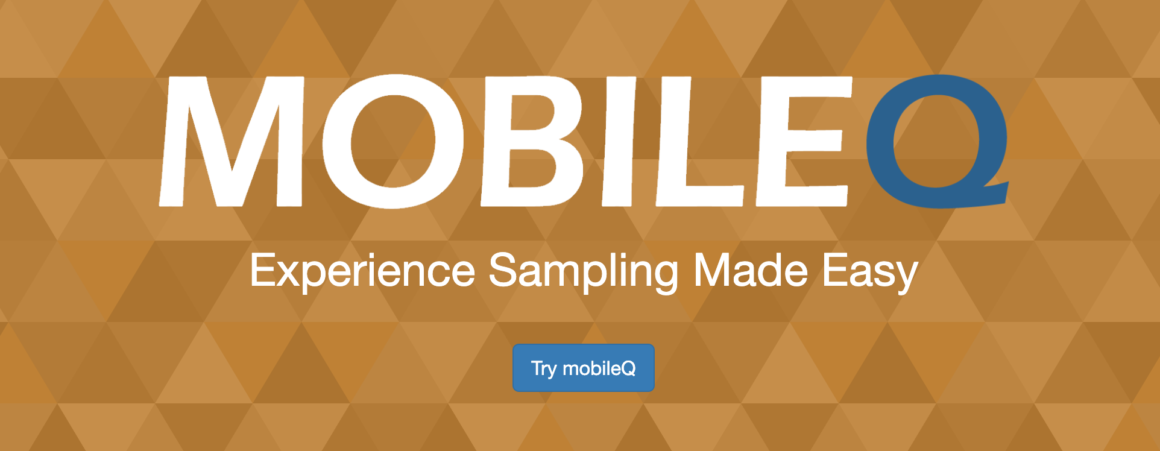Peter Kuppens is Professor of Psychology at KU Leuven-University of Leuven in Belgium. He studies the nature and dynamics of emotions in their natural habitat, daily life, and how they play a role in well-being and mood disorder. His research group has developed an Android smartphone platform, called mobileQ, to perform experience sampling research, which he talks about in this blog.
Experience Sampling Method (ESM) aka Ecological Ambulatory Assessment (EMA) is becoming ubiquitous in research investigating the nature and dynamics of everyday psychological phenomena.
A brief history
When our research group started doing ESM research back in 2004, we used special wristwatches that could be programmed to beep at fixed timepoints. Participants wore these watches on their other wrist than their usual watch, and when they beeped, took out a booklet to complete a pencil-and-paper survey. To my surprise, dual watches did not become a fashion thing. This method helped us collect the data we were after, but it was laborious and time-consuming to enter the data and not great for participant compliance. I think it was around 2007 that we moved to palmtop computers. Yes, it fit in the palm of your hand, but “computer” was a bit of an overstatement! The device could be used for notes and calendar keeping, but could not call, text, or browse the internet, let alone tweet or find you a date (and it cost more than a modern smartphone!). But it worked well for beeping participants and digitally recording their responses to the questions we formulated. We used iESP to program our palmtop studies, and I am still indebted to Barrett and Barrett (2001)1 for making these devices amenable for ESM research and for instilling in me the jealousy to also one day publish a paper that has my name on it twice.
The age of the smartphone
Flash forward to 2011, when we figured we should join the smartphone age. It was easy to purchase smartphones, but less easy to do ESM research on them. There were a few homegrown software platforms available, but they suffered from various ailments. There were a few paid platforms available too, but they quickly became expensive when you had plans to conquer the world, cure cancer, and halt all psychopathology with ESM research. So we thought it would be easiest to just make our own software to program smartphones. That was an underthinkment! It took us several years to make something that is easy to use, does not require any programming or coding experience from the part of the user, is reliable in terms of data collection and storage, and has enough flexibility to accommodate most of the varieties of research protocols typically encountered in ESM research. We called it mobileQ. While many people were involved in its development along the way, it was Kristof Meers who was the driving force and coding genius that made it all happen and work.
MobileQ
We and our collaborators have been using mobileQ for several years now. In total, it has collected over 7 million responses from 200,000+ surveys. From the start, it was our plan to also make our ESM smartphone brainchild freely available to other researchers. Yet, this also took longer than expected, as we had to properly document its features for novice researchers and to figure out the Terms and Conditions and Privacy statements researchers should agree to when wanting to use mobileQ. This turned out to be our biggest obstacle in today’s GDPR and lawsuit-obsessed age (a big thanks here to the KU Leuven R&D department).
So here it is.

We are very happy to make available to you, the research community, a free and flexible platform to perform ESM research. Let me explain a number of its features, advantages and possible disadvantages. Aside from being free, a big advantage is that we hope it is easy to use for novice researchers and is able to accommodate most (standard) ESM protocols, including different questions types, randomization options, flexible time-points, possibility for both time and event-sampling, and so on. As a simple research group, we cannot afford to set up a call-center or helpdesk to answer all questions and queries. Yet, we have documented all features as well as possible with an accompanying paper (Meers , et al., 2019)2 and instructional videos featuring the irresistible Aussie accent of Elise Kalokerinos and the video editing skills of Egon Dejonckheere. There is also a forum for researchers to post questions that we will also monitor ourselves.
MobileQ’s focus on Android
One potential drawback perhaps is that mobileQ only works on Android phones, and we would advise that it would be best to work with specific types of research dedicated phones. That is, we suggest that researchers buy their own Android phones for their labs and install mobileQ on these phones (which are cheap these days: recommended devices do not cost a lot more than 100 euros or dollars). Why? One first reason is perhaps that we came from palmtops and that research dedicated devices did not seem unreasonable at the time. A second reason is that unlike today, when we started it was difficult to develop something that worked on both Android and iOS. But I also think there is a case to be made to use research dedicated phones. First, they may aid compliance. Participants see it as a research instrument that they may ignore less easily than their own smartphone, they cannot tinker with the notification settings (or avoid notifications!), and their phone cannot interfere with notification systems (something we have found problematic in some versions of Android with a particularly persistent battery saver model). Second, you have more control over what is displayed, and it is displayed in a way that is uniform across participants. Third, you can include all participants, even those without a smartphone (important for some populations e.g. older adults).
Protected servers & GDPR
Currently, mobileQ is available for free use from our own KU Leuven protected servers. The platform is GDPR compliant and takes into account today’s security, legal, and privacy requirements (of course, you are still responsible for the nature of the data you collect). In addition, we will make the code open-source across the course of 2019. This option will allow to store your data on your own servers, a requirement perhaps at some institutions, especially when collecting sensitive data. Perhaps more importantly, it will also allow you, the research community, to further build on our work and adapt and enhance mobileQ for whatever purpose and functionality you need on top on what is already there.
Feel free to try it out.
From our point of view, we are happy we are able to give something to the research community that may hopefully help along your research, and in doing so, help us understand the complexity of human behavior, thoughts, and emotion (and who knows, cure cancer).
Peter Kuppens
with thanks to all involved in the development of mobileQ including Marlies Houben, Pete Koval, Madeline Pe, Koen Rummens, …
- Barrett, L. F., & Barrett, D. J. (2001). An introduction to computerized experience sampling in psychology. Social Science Computer Review, 19(2), 175-185.
- Meers, K., Dejonckheere, E., Kalokerinos, E. K., Rummens, K., & Kuppens, P. (2019). mobileQ: A free user-friendly application for collecting experience sampling data. https://doi.org/10.31234/osf.io/ynj7e

Pingback: Brief psychology news 07/2019 - Eiko Fried